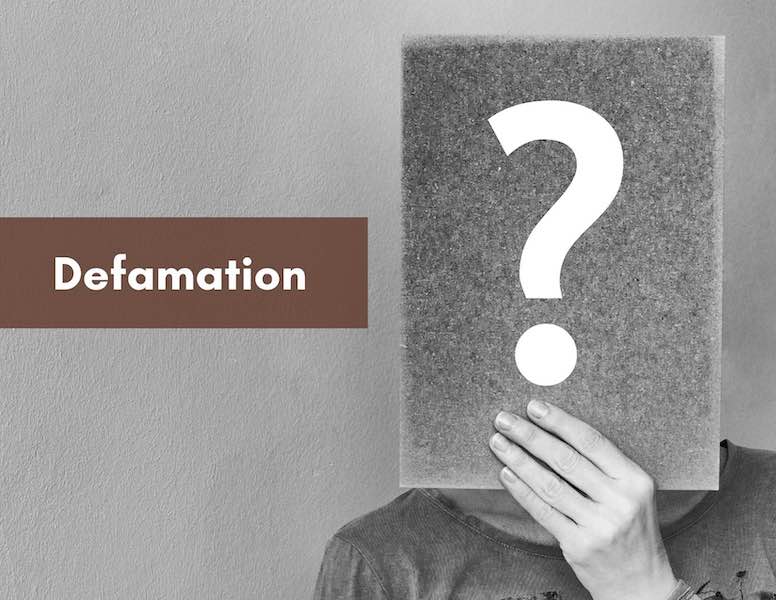Those Who Assert Must Prove: Testifying in a Defamation Suit
by Alliff Benjamin Suhaimi & Yong Huey Leng ~ 13 September 2021
Introduction
As the 1MDB Scandal unfolds over the past few years, there were numerous publications exposing the mega financial scandal which have captured the world’s attention. One such example is the New York Times Bestseller ‘Billion Dollar Whale’ which had stirred some political hornet’s nests. Afterall, who doesn’t love a sensational story digging into “the heist of the century”?
In 2018, Claire Rewcastle-Brown, published her own account and investigations of the scandal in her book, 'The Sarawak Report -The Inside Story of the 1MDB Expose'. Her bombshell of a report resulted in her, the publisher and printer of the book being hit with a RM 100 million defamation lawsuit initiated by the Terengganu Sultanah, Tuanku Nur Zahirah (“the Plaintiff”).
The Plaintiff, in her Statement of Claim, alleged that the book made disparaging remarks against her which implied as follows:-
- The Plaintiff was involved in corruption practices.
- The Plaintiff had used her status to influence the establishment of the Terengganu Investment Authority (TIA), which later became 1MDB.
- The Plaintiff helped Jho Low to become the adviser of TIA.
Subsequent to the filing of the suit, the Plaintiff filed an application pursuant to Order 14A of the Rules of Court 2012 (“ROC 2012”) for the matter to be summarily determined without the need for any witnesses to be called by the Plaintiff. In essence, the Plaintiff sought for her case to be made out without the need for any oral testimony.
In December 2019, the High Court allowed the Plaintiff’s application and determined that based on the affidavits, there is a prima facie case that the Defendants had defamed the Plaintiff and she was exempted from testifying in court. The burden now shifts to the Defendants to prove their defences at the full trial. Dissatisfied, the Defendants lodged an appeal against the decision of the High Court.
Recently on 26th August 2021, the Court of Appeal allowed the Defendants’ appeal and set aside the earlier High Court decision. In allowing the appeal, the Court of Appeal held that the Plaintiff must provide evidence by way of oral testimony in order to prove her case of defamation against the Defendants.
The Court of Appeal also held that there is an antidote in the book which must be read together with the purported defamatory statement when ascertaining whether the publication is indeed defamatory. In other words, the statements must be read in its whole context. As such, the case must be determined by way of full trial with witnesses.
In this article, we will look into the 3 main issues determined by the Court of Appeal in this case, namely:-
- the requirement of Plaintiff to testify in trial;
- the defamation suit must go for full trial; and
- the publication must be read as a whole when ascertaining whether the statement is defamatory
Plaintiff Ought to Testify in Court
As a general rule, a suit which contains material disputes of facts must be determined by way of full trial with witnesses in accordance with Orders 35 and 38 of the ROC 2012 which establishes the general principle that evidence of fact is to be given orally in an open court. Only in exceptionally rare cases, a Judge can depart from the normal procedure as prescribed under this rule.
For example, the Court can invoke its powers under Order 33 Rule 5 of ROC 2012 to do away with the normal trial procedure of calling and examining witnesses if the Judge is of the view that the issues in a case can be decided by merely considering the agreed facts, affidavits and written submissions of parties. As explained above, a party can move an application under Orders 14A or 33 of ROC 2012 for certain questions to be determined without the need to go for full trial. However, such manner of determination is only suitable when there are no serious or material disputes of facts.
Although the Court has powers to depart from the normal procedure under Order 38 r1, the High Court in Toh Hong Cheng v Bumiputra-Commerce Bank Bhd [2008] 7 MLJ 417 held that the Court must tread fairly and with care before adopting the exceptional procedures. In this case, the Court set aside the previous judgment which was made without the benefit of a full trial as the Court finds that it is highly irregular to do so.
It is pertinent for the Court to consider all evidence presented in trial in order to satisfy the threshold or standard required in proving a case. The Federal Court in Inas Faiqah Mohd Helmi v Kerajaan Malaysia [2016] 2 CLJ 885 highlighted the importance of considering the threshold of evidence:-
“The standard of proof in civil cases is the legal standard to which a party is required to prove its case, namely on a balance of probabilities. In civil litigation, the question of the probability or improbability of an action occurring is an important consideration to be taken into account in deciding whether that particular event had actually taken place or not.”
A Plaintiff must also bear in mind that the Court has powers under O35 r2 of ROC 2012 to dismiss an action if the Plaintiff does not attend trial as the case for the Plaintiff remains unproven. The importance of ensuring the presence of Plaintiff as a witness at trial was illustrated in the case of Anne Lim Keng See (trading as Golden Kintex-Sole-proprietorship) v Malayan Banking Bhd [2009] 9 MLJ 502 where the High Court dismissed the case on the basis that the Plaintiff was absent in trial.
A Defamation Suit should be Determined by Way of a Full Trial
In defamation cases, the Plaintiff bears the burden to prove the alleged defamation by producing the necessary evidence and witnesses that the statements complained of are defamatory of the Plaintiff. To succeed in a defamation action, the Plaintiff must persuade the Court that the following elements are satisfied:-
- The words complained of are defamatory;
- The defamatory statement refers to the Plaintiff; and
- The defamatory statement has been published by the Defendant to a 3rd party
In order to determine whether an Order 14A application is suitable to dispose of a libel claim, the High Court in YB Ding Kuong Hung, MP v Dr Wong Hua She [2011] MLJU 414 held that there are 2 steps that must be considered. Firstly, the Court will determine whether the words complained of bears a defamatory meaning. This is a question of law for the Judge to decide. Next, the Court will ascertain whether the words complained of are in fact defamatory. This is a question of fact which has to be determined on a case to case basis. If it is unclear whether the words are defamatory, then Order 14A application must be dismissed.
The Federal Court in Kerajaan Negeri Kelantan v Petroliam Nasional Berhad & Other Appeals [2014] 7 CLJ 597 has explained that an Order 14A application would generally not be suitable if the facts in a case are disputed. In a more recent case, the Federal Court in Chong Chieng Jen v Government of the State of Sarawak [2019] 1 CLJ 329 held that an Order 14A application was refused on the basis that the question of whether the impugned words were in fact defamatory is best decided by way of a full trial with viva voce evidence.
In the Sultanah’s case, the Court of Appeal held that the 2 questions of whether the statement in the book is defamatory of the Plaintiff and whether it is in fact defamatory are mixed questions of law and fact. Therefore, the suit should proceed to a full trial to determine the full context of the publication after hearing oral evidence of all witnesses.
Publication must be Read as a Whole
Apart from the above, the Defendants in the Sultanah’s case also argued that there was an antidote at page 438 of the book which must be determined at trial. The Court of Appeal agreed that in ascertaining whether the words are defamatory, the antidote must be read together with the purported defamatory statement.
It is settled law that in order to determine whether the words complained of are in fact defamatory, the publication must be read as a whole and not in isolation. The High Court in Datuk Husam Musa v Utusan Melayu Bhd. & Ors. [2015] 6 CLJ 760 held that: “the meaning to be ascribed to words allegedly defamatory has to be construed by taking the contents of the publication as a whole.”
Other than the contents of the publication, the High Court in Asia Pacific Higher Learning Sdn Bhd v Eagle One Investment Sdn Bhd & Ors [2018] 1 LNS 56 held that it must take into account the introduction and conclusion of an article because they are indicators as to the context and what the writer is trying to convey.
In the same light, the principle of bane and antidote requires the context and circumstances of the publication to be taken into account. Hence, the Plaintiff cannot pick and choose parts of the publication which, if read alone, would be defamatory (the ‘bane’). If there are other parts of the publication (the ‘antidote’) which would remove or negate the ‘bane’, then it must be taken together. According to the High Court in Dato' Seri Anwar bin Ibrahim v The New Straits Times Press (M) Sdn Bhd & Anor [2010] 2 MLJ 492, the proper approach in determining whether a publication is defamatory is to consider the words complained of in the context of the whole publication. The Court held that a plaintiff cannot select an isolated passage in an article and complain of that alone if other parts of the article throw a different light on that passage.
Whether the antidote is effective in neutralising the sting of the libel would depend on whether an ordinary reasonable reader would still have reached the conclusion that the words complained of are defamatory of the Plaintiff, after reading the publication as a whole.
In allowing the appeal by the Defendants, the Court of Appeal agreed that the bane and antidote is an issue in the Sultanah’s suit which has to be determined by way of a full trial and the same cannot be determined summarily.
Conclusion
In light of the Court of Appeal’s decision above, it must be emphasised that defamation law is a balancing act of protecting one’s right to reputation and right to freedom of speech. It is our view that that the Court of Appeal has struck an appropriate balance between the two rights by reaffirming that a full trial is necessary and that the full context of publication must be considered when determining whether an impugned statement is in fact defamatory.
In the spirit of justice, the Courts will be better assisted in arriving at an objective decision after hearing oral evidence from witnesses surrounding the facts and circumstances of the publication. Therefore, if one is to sue for defamation, one must be ready to come to court and testify as to why he or she thinks they have been defamed.

